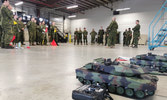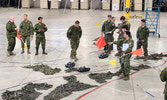The Evolution of Training: Remote-Controlled Tanks
Lieutenant Jonathan “I swear, I am actually good at Volleyball” Barton (22)
In the relentless pursuit of operational readiness, with a sprinkle of necessity, B Squadron's integration of Remote-Controlled (RC) Tanks into their Tactical Exercises Without Troops (TEWT) heralds a new era in Strathcona training methodology.
On the heals of receiving initial Direction and Guidance from Lieutenant-Colonel Darryn “I have an idea for you” Gray (9), B Squadron made a mad dash at the end of the last fiscal year to seize an opportunity to break new ground. Thanks completely to the quick work of Captain Yuan “Of course I will drop any work to play with toys” Hu (29B), within hours the Regiment committed to a trial of purchasing eight 1:16 scale Leopard 2A6 Tanks. Upon our return from Spring Break, in April, B Squadron quickly embarked on a journey of innovation, leveraging civilian technologies to enhance the realism and effectiveness of their training. Poised for greatness and fully committed to the Reconstitution Phase, B Squadron was full of junior or newly qualified personnel eager for any type of “tank” training.
While leadership figured out how to integrate the new training aids, TEWT 1 was launched with the aim of laying out the groundwork for subsequent training sessions. Focusing on battle procedure and tactical planning at the Squadron- and Troop-levels, squadron leadership engaged in discussions revolving around various tactical tasks, developing courses of action, and setting the stage for the practical application of tactics and maneuvers in later exercises. Adapting the Primary Core Function (PCF) training methodology, crews learnt RC Tank driving, gunning, and crew commanding, with the ever-important maintenance that always follows tanks, just at a miniature scale. For the junior Troop Leaders, this orientation served as a crucial learning experience, ensuring they had a solid understanding of tank tactics before moving on to more complex scenarios. Ultimately TEWT 1 was a shakeout with many lessons learnt.
The introduction of RC Tanks in TEWT 2 marked a significant milestone in the development of this bespoke training program. Shifting from our PCF mindset, B Squadron launched fully into our Level-4 training model with a Squadron minus scenario. With make-shift crews comprising of a driver/gunner and a crew commander, soldiers experienced a dynamic and immersive training environment where they honed/developed new skills in a Squadron Advance to Contact scenario. The realistic features of the RC Tanks, including shooting BBs, smoke simulation and audible feedback, provided soldiers with invaluable hands-on experience in maneuvering and engaging enemy positions. While never intended to be a replacement for the real thing, this quickly became an opportunity for soldiers of all experience levels to challenge themselves and to push new horizons. Beyond its tactical implications, the integration of RC Tanks offers a unique opportunity for crew commanders, gunners, and drivers to refresh and maintain their skills. Crew commanders were able to sharpen their leadership abilities, overseeing operations and making critical decisions in real-time, while gunners and drivers, on the other hand, benefited from exposure to reacting to commands and working seamlessly as part of a cohesive crew unit. TEWT 2 saw a variety of crew commanders, ranging from experienced to no experience at all, each bringing their own strengths and challenges to the table. This diversity allowed for a rich learning opportunity, as soldiers navigated through the complexities of battlefield command and coordination. As a side effect of the training, limited comms posed a challenge for all, forcing crew commanders to resort to flags and hand signals to communicate adding to the fog of war. To gain the attention of one of their junior callsigns, who already had limited crew commanding experience, 2Lt Chris “No worries I got this…!” Lee (24) even resorted to the use of interpretive dance to ensure their message was passed.
TEWT 2.5 showcased the versatility and adaptability of RC Tanks in training scenarios. With a complete reshuffling of crews, participants staged at the Line of Departure and prior to H-Hour received hasty attack orders setting the conditions for a swift combat team attack on an enemy mechanized platoon position, demonstrating a progressive level of skill and proficiency. Due to external pressures this particular TEWT was executed on short notice which further added an element of urgency and realism to our training. Moreover, it provided an opportunity for the incoming Brigade Commander to observe the training opportunities and capabilities offered by the RC Tanks firsthand, further highlighting their value in enhancing Strathcona readiness and preparedness.
While initial reactions were mixed when B Squadron fielded the first RC Tank Squadron in our Regiment, the value was quickly recognized. Of course RC Tanks will and should never replace traditional training, the ability to “deploy” notionally to conduct Squadron- or Troop-level maneuver at almost no cost and without impacting time away from home was significant. This blend between conducting a TEWT with a large-scale sand table has already proven to be of great value for junior soldiers to rehearse drills, review Training, Tactics and Procedures, and to develop leaders (even without formal PCFs) within individual call signs.







